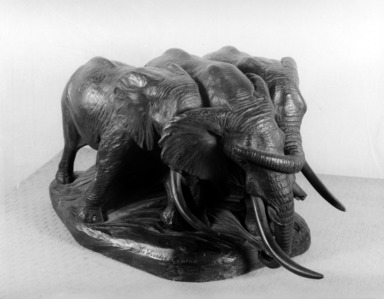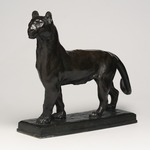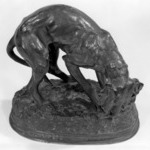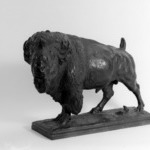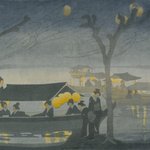The Wounded Comrade
Carl E. Akeley
American Art
On View: Luce Visible Storage and Study Center, 5th Floor
Carl Ethan Akeley was a well-known naturalist and taxidermist who worked for many years at the American Museum of Natural History (1909-26). After his first trip to Africa in 1896, Akeley conceived the idea of creating a full-scale African diorama to show the animals in their natural habitat. The Wounded Comrade depicts a scene that Akeley had directly observed in the wild: when an elephant is wounded, others from the herd will rush in and attempt to convey it to safety. Akeley's production of art bronzes was the direct result of his working habit of making clay models to design dioramas. A fellow sculptor, Alexander Phimister Proctor (whose works are on exhibition nearby), suggested that Akeley cast a series of these models into bronze. The first and most famous work in the series is The Wounded Comrade.
MEDIUM
Bronze
DATES
1913
DIMENSIONS
11 1/2 x 20 1/2 x 10 1/2 in., 46 lb. (29.2 x 52.1 x 26.7 cm, 20.87kg)
(show scale)
MARKINGS
Foundry mark inscribed on proper rear of base: "ROMAN BRONZE WORKS N.Y."
SIGNATURE
Inscribed on proper front right corner of base: "The Wounded Comrade / © Carl E Akeley / 1913"
ACCESSION NUMBER
13.14
CREDIT LINE
Gift of George D. Pratt
CATALOGUE DESCRIPTION
Statuette of three bronze elephants standing in tightly packed group; they press their bodies pressed together and wrap their trunks around each other; on ovoid base.
Condition: good
CAPTION
Carl E. Akeley (American, 1864–1926). The Wounded Comrade, 1913. Bronze, 11 1/2 x 20 1/2 x 10 1/2 in., 46 lb. (29.2 x 52.1 x 26.7 cm, 20.87kg). Brooklyn Museum, Gift of George D. Pratt, 13.14. Creative Commons-BY (Photo: Brooklyn Museum, 13.14_bw.jpg)
IMAGE
overall, 13.14_bw.jpg. Brooklyn Museum photograph
"CUR" at the beginning of an image file name means that the image was created by a curatorial staff member. These study images may be digital point-and-shoot photographs, when we don\'t yet have high-quality studio photography, or they may be scans of older negatives, slides, or photographic prints, providing historical documentation of the object.
RIGHTS STATEMENT
Creative Commons-BY
You may download and use Brooklyn Museum images of this three-dimensional work in accordance with a
Creative Commons license. Fair use, as understood under the United States Copyright Act, may also apply.
Please include caption information from this page and credit the Brooklyn Museum. If you need a high resolution file, please fill out our online
application form (charges apply).
For further information about copyright, we recommend resources at the
United States Library of Congress,
Cornell University,
Copyright and Cultural Institutions: Guidelines for U.S. Libraries, Archives, and Museums, and
Copyright Watch.
For more information about the Museum's rights project, including how rights types are assigned, please see our
blog posts on copyright.
If you have any information regarding this work and rights to it, please contact
copyright@brooklynmuseum.org.
RECORD COMPLETENESS
Not every record you will find here is complete. More information is available for some works than for others, and some entries have been updated more recently. Records are frequently reviewed and revised, and
we welcome any additional information you might have.
